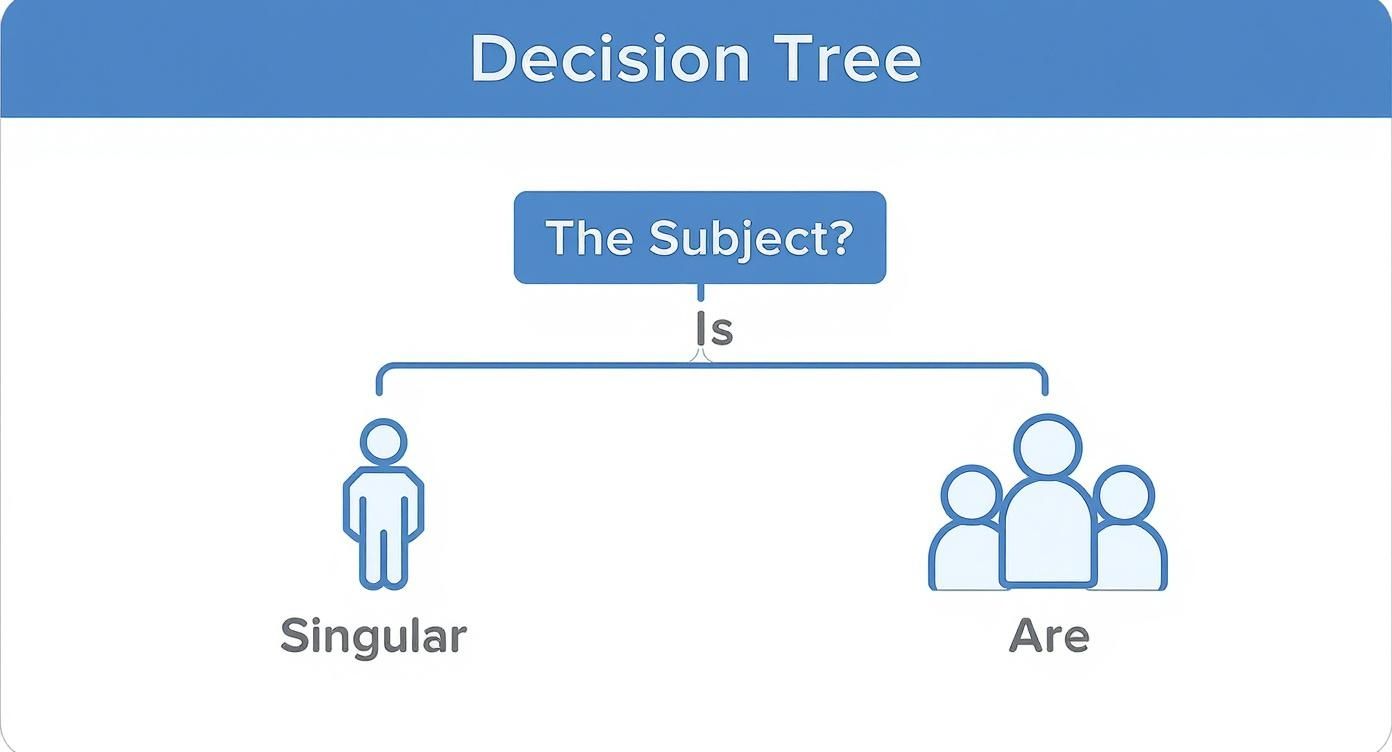Grammar Is vs Are: Your Guide to Correct Verb Choice

The real difference in the "is vs are" debate boils down to one simple thing: ‘is’ is for a single subject, and ‘are’ is for multiple subjects. Getting this right is all about making sure your verb matches the number of things you're talking about, a key grammar idea called subject-verb agreement.
The Basic Rule of Is vs Are
At its heart, choosing between ‘is’ and ‘are’ is a simple counting game. If you're talking about one person, place, or thing (a singular subject), you’ll use is. If the subject is plural—meaning more than one—you stick with are. This rule is the foundation of clear, professional writing.
Think of it as a basic pairing system. The verb has to agree with its subject in number. So, 'is' naturally pairs up with singular nouns and pronouns like 'he,' 'she,' and 'it.' On the other hand, 'are' is the go-to for plural nouns and pronouns like 'they' and 'we.' It also works with 'you,' whether you're talking to one person or a group.
Getting a firm grip on this rule is a huge first step toward better writing. For more practical advice on leveling up your communication, check out our complete guide to improve English writing skills.
Quick Guide: Is vs Are at a Glance
To make this perfectly clear, let’s look at the rule in action. This table is a great little cheat sheet for making the right choice without overthinking it.
| Subject Type | Correct Verb | Example Sentence |
|---|---|---|
| Singular (one item) | is | The book is on the table. |
| Plural (multiple items) | are | The books are on the table. |
| Singular Pronoun | is | She is running late. |
| Plural Pronoun | are | They are running late. |
As you can see, the subject tells the verb what to do. Once you start noticing this pattern, it becomes second nature.
Handling Tricky Collective Nouns
Collective nouns like ‘team,’ ‘family,’ or ‘committee’ can be real head-scratchers when deciding between ‘is’ or ‘are.’ These words point to a group, but the real question is whether that group is acting as a single, unified body or as a collection of individuals. Your choice often comes down to context and, believe it or not, geography.
The key is to figure out the noun’s role in the sentence. If the group is acting in unison—as one cohesive unit—treat it as singular and use is. But if the members are acting individually or are being highlighted as separate parts of the whole, you’ll want to treat it as plural and use are.
For instance, "The team is winning the championship" paints a picture of a unified group succeeding together. On the flip side, "The team are discussing their individual strategies" makes it clear that the members are acting as separate agents within the group. Getting this distinction right is important for clear writing.
This simple decision tree helps show whether the subject of your sentence needs 'is' or 'are'.
As the visual shows, the first step is always figuring out whether your subject is a single unit or a group of individuals. That choice tells you which verb to use.
American vs British English Differences
Just to add another layer of complication, American and British English handle this differently. In American English, collective nouns are almost always treated as singular. Over in British English, it’s much more common to treat them as plural, especially when you want to draw attention to the individuals making up the group. You can explore more of these grammatical nuances to get a deeper understanding of sentence structure.
Key Takeaway: American English usually defaults to treating the group as a single unit ('The government is making a decision'), while British English is more comfortable focusing on the members ('The government are debating the issue').
Choosing the correct verb depends on your intended meaning and where your audience is based. If you're ever in doubt, just aim for consistency. Pick one approach and stick with it throughout your writing to keep things straightforward and professional for your readers.
Navigating Compound Subjects and Phrases
Choosing between "is" and "are" gets a bit murky when a sentence has more than one subject. These are called compound subjects, but a couple of simple rules can clear things up fast.
The most common compound subjects are linked by the word 'and.' When you connect two or more subjects with 'and,' they act as a plural unit. That means you'll almost always need the plural verb are.
- Example: The laptop and the monitor are on the desk.
- Example: Sarah and Tom are going to the movies.
In both sentences, you're talking about two separate things or people together, which makes the subject plural. This is one of the most dependable rules in the whole 'is' vs 'are' debate.
The Proximity Rule With Or and Nor
But things get interesting when subjects are joined by 'or' or 'nor.' In these cases, the verb needs to agree with whichever subject is physically closest to it in the sentence. This is called the proximity rule.
Key Takeaway: With 'or' or 'nor,' just look at the last subject listed. If it's singular, use 'is.' If it's plural, use 'are.'
Check out these examples:
- Neither the manager nor the employees are happy with the decision. (The plural 'employees' is right next to the verb, so we use 'are'.)
- Either the dogs or the cat is making that noise. (The singular 'cat' is closer, so we go with 'is'.)
Another common trip-up is when phrases get wedged between the subject and the verb. Words like 'along with,' 'as well as,' or 'in addition to' don't actually change the subject from singular to plural. Your job is to find the real subject and ignore the extra fluff.
- The report, along with all its attachments, is due today.
Here, the true subject is "report"—which is singular. The phrase "along with all its attachments" is just extra information. Even experienced writers can stumble on this. If you're curious about how technology handles these fine points, you might want to read our guide on whether ChatGPT can proofread your paper for these kinds of subtleties. By focusing in on the main subject, you can pick the right verb with confidence every single time.
The Curious Case of Data Is vs Data Are
Few words stir up the grammar is vs are debate quite like 'data.' Its journey from a strict Latin plural to a modern mass noun is a perfect example of how language changes over time. Getting a handle on this shift is the key to picking the right verb for your audience and sounding like you know what you're talking about.
This debate isn't new. Technically, 'data' is the plural of the Latin word 'datum,' which is why 'data are' was traditionally the only correct choice in formal and scientific writing. However, as the word moved into journalism and business, it started being treated as a singular mass noun, just like 'information.' This change is so major that even the UK's Office for National Statistics blog has weighed in on the discussion.
Choosing Between Data Is and Data Are
So, which one is "correct"? It all comes down to context. If you're writing for academic, scientific, or highly technical fields, it's safer to stick with the traditional 'data are.' This usage respects the word's origins and treats 'data' as a collection of individual points or facts.
On the flip side, 'data is' has become the standard in most business communications, marketing content, and everyday conversation. In these situations, 'data' acts as a single, unified idea—much like 'water' or 'sand.'
Knowing your audience is vital for good communication, and that includes understanding the right types of diction to use. The table below breaks down the common scenarios for each form.
When to Use 'Data Is' vs 'Data Are'
To make it simple, here's a quick reference guide on when to use each phrase based on your context and audience.
| Usage | Common Context | Example Sentence |
|---|---|---|
| Data is (Singular) | Business, marketing, journalism, casual conversation. | The data is clear and shows a positive trend. |
| Data are (Plural) | Scientific papers, academic research, formal reports. | The data are collected from multiple independent trials. |
Think of it this way: are you talking about a single block of information, or the individual pieces that make it up? Your answer will usually point you in the right direction.
Key Takeaway: For most daily writing, 'data is' will sound natural and correct. Reserve 'data are' for more specialized, academic audiences who value the traditional plural form. When in doubt, consider your reader's expectations.
Getting a Handle on Indefinite Pronouns and Quantifiers
Indefinite pronouns and quantifiers throw a common wrench into the is vs. are debate. Words like 'everyone,' 'nobody,' 'some,' and 'all' don’t point to a specific thing, which can make verb agreement feel like a guessing game. But don’t worry, the rules are actually pretty solid once you get the hang of them.
Lots of indefinite pronouns are always singular, even when they feel like they’re talking about a group. Think of words like everyone, everybody, someone, somebody, anyone, anybody, no one, and nobody. These always take the singular verb is.
- Everyone is invited to the party.
- Nobody is going to be left out.
On the flip side, a few indefinite pronouns are always plural. This group includes several, few, both, and many. Since they inherently mean more than one, they always get paired with are.
- Several of the reports are missing.
- Both are good options.
The Tricky Middle Ground
The pronouns that trip most people up are the ones that can swing either way. Words like some, all, any, most, and none are chameleons—their verb depends entirely on the noun they’re describing.
Here's the trick: if the noun is singular or can't be counted (like water or advice), use is. If the noun is plural and countable (like cookies or chairs), use are.
You have to look at the object of the prepositional phrase that usually follows. That little detail is your key.
- Some of the pie is gone. (Here, pie is a single, non-countable item.)
- Some of the pies are gone. (Pies are plural, countable items.)
The same logic works for quantifiers like "a number of" and "the number of." Just think of "a number of" as a synonym for "many," which is plural. In contrast, "the number of" points to one specific figure, which makes it singular.
- A number of people are waiting outside.
- The number of people waiting is twelve.
Common Mistakes and How to Fix Them
Knowing the rules of grammar is vs are is half the battle. The other half? Spotting those sneaky mistakes in your own writing. Even experienced writers get tripped up by a few common pitfalls that throw subject-verb agreement out of whack.
One of the most frequent errors pops up when a long phrase separates the subject from its verb. All those extra words can make you lose track of what the sentence is actually about, leading you to pick the wrong verb.
Correction Tip: To fix this, just temporarily ignore the interrupting phrase. Read the sentence with only the main subject and the verb to see if they click.
- Incorrect: The list of new regulations, which applies to all departments, are confusing.
- Correct: The list of new regulations, which applies to all departments, is confusing.
Fixing Other Common Errors
Another classic trouble spot is any sentence starting with "There is" or "There are." In these constructions, the subject actually shows up after the verb, which can feel a bit backward. You have to look ahead in the sentence to find the true subject before you can choose the right verb.
- Incorrect: There is many reasons for the delay.
- Correct: There are many reasons for the delay.
Finally, titles of books, movies, or even company names can be misleading. They might sound plural, but they are always treated as a single entity, meaning they need a singular verb.
- Incorrect: "The Avengers" are my favorite movie.
- Correct: "The Avengers" is my favorite movie.
A solid grasp of verb agreement is vital for clear communication and is a big step in learning how to speak English fluently. It's worth remembering that even AI tools can miss these details; it helps to understand does ChatGPT make grammar mistakes when using them for assistance. By learning to spot these common slip-ups, you'll be able to edit your own work with much more confidence.
To ensure your writing is always clear, natural, and error-free, consider using Word Spinner. Its strong rewriting functions can help you humanize content, remove AI detection signatures, and produce 100% plagiarism-free text that sounds polished and professional.


